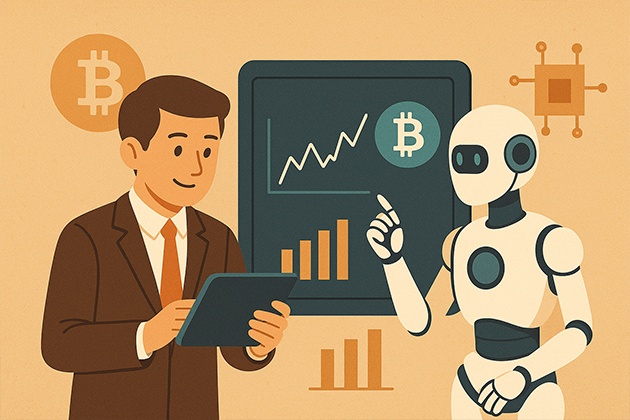The incorporation of artificial intelligence into cryptocurrency trading is a logical reaction to the distinct features of the market. Cryptocurrencies, in contrast to traditional assets, are subject to a variety of technical, social, and regulatory issues, operate around the clock, and are extremely volatile. The vast amount of data created in real time, ranging from news events and macroeconomic indicators to blockchain activity and social emotion, is frequently too much for human traders to handle.
AI can quickly evaluate and interpret this data, producing insights that would be practically hard for humans to produce on their own. For instance, machine learning algorithms are able to analyze relationships between assets, find patterns in past price data, and even spot anomalies that could be signs of future trends. These systems get better over time by taking lessons from past mistakes and achievements.
Trading Bots Driven by AI
Automated trading bots are among the most well-known uses of AI in cryptocurrency trading. These systems are capable of carrying out trades in response to market conditions, AI-generated forecasts, or pre-established strategies.
- AI trading bots lower the chance of lost chances by reacting to market changes in milliseconds.
- Bots can keep an eye on several exchanges at once, guaranteeing the best trade pricing.
- Bots can adjust to shifting market conditions thanks to machine learning, which gradually boosts performance.
AI bots provide more methodical strategy execution by eliminating the emotional element of trading. However, the caliber of the training data and the underlying algorithms determine how effective they are.
Forecasting the Market and Predictive Analytics
Predictive analytics is another area where AI is changing cryptocurrency trading. AI models are able to take into account a large number of parameters at once, unlike traditional technical indicators. Social media trends, news mood, blockchain analytics, and even geopolitical happenings are included in addition to historical price and volume data.
These forecasting tools are especially helpful in erratic markets where quick changes can result in large profits or losses. By incorporating AI-driven projections into their tactics, traders can improve the efficiency of their decision-making by more precisely predicting market movements.
Controlling Risk With AI
Successful trading relies heavily on risk management, and AI offers new resources for reducing exposure. The likelihood of unfavorable events can be evaluated by machine learning algorithms, which can then suggest changes to stop-loss levels or position sizes.
Portfolio optimization is another area in which AI systems shine. Traders can build diversified portfolios that strike a balance between risk and possible profits by analyzing connections between different cryptocurrencies and other assets. By taking a proactive stance, traders can lessen their susceptibility to significant drawdowns and adjust to unforeseen market events.
Improving the Development of Strategies
AI contributes to the creation of trading strategies in addition to execution and forecasting. AI can determine which methods have the best chance of succeeding by testing various settings and simulating a large number of scenarios. Traders can develop and improve strategies that could be too difficult or time-consuming for manual examination thanks to this experimental capabilities.
- AI-powered backtesting aids in strategy validation against historical data.
- Traders can predict outcomes under extreme market conditions by using scenario analysis.
- Proactive investors can get an advantage by using AI to detect trading signals that were previously missed, ensuring they receive more accurate trading signals to base their decisions on.
AI’s Difficulties in Crypto Trading
AI in cryptocurrency trading is not a panacea, despite its promise. Both professional and private traders must take into account certain difficulties.
- Quality of data: AI models can be distorted by noisy or inaccurate data, and cryptocurrency markets are vulnerable to manipulation.
- Risks of overfitting: AI programs that are trained on sparse amounts of historical data may function well in backtests but poorly in real-world scenarios.
- The unpredictable nature of the market Algorithms can’t always forecast black swan occurrences, such exchange crashes or government restrictions.
- Accessibility: Because of their high cost or technical complexity, cutting-edge AI systems are frequently still out of reach for regular traders.
These difficulties highlight the necessity of having reasonable expectations when integrating AI into actual trading.
The Partnership Between Humans and AI
Although AI is strong, it works best when paired with human wisdom. Skilled traders are able to use judgment, evaluate AI outputs, and make strategic choices that robots cannot completely duplicate. This partnership makes it possible to strike a balance between human intuition and computational accuracy.
Better risk management, more rapid analysis, and disciplined execution are all advantages for investors who use AI while keeping supervision. Future trading organizations that successfully combine AI skills with human experience are probably going to be the most successful.
Prospects for the Future
AI’s influence in cryptocurrency trading will only grow as it develops further. More advanced market analysis will be possible because to emerging technologies like reinforcement learning and natural language processing. In the future, AI may be able to predict changes in market mood, maximize liquidity, and tailor trading plans for specific investors.
AI-powered trading has the potential to create more liquid and efficient markets in the long run. To make sure that these tools improve market justice rather than increase dangers, traders and engineers must overcome moral and legal obstacles.
Financial markets are undergoing a paradigm shift as a result of the integration of AI and cryptocurrency trading. Traders may execute more quickly, manage risk more skillfully, and obtain better insights by utilizing AI’s computational capabilities. However, the human factor is still crucial in ensuring that methods are ethical, flexible, and grounded in the actual world.










